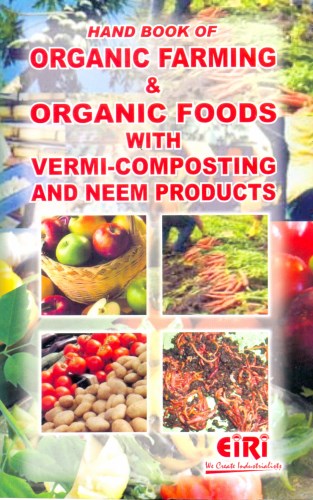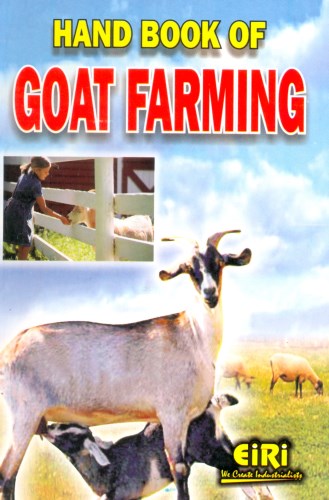Description
HAND BOOK OF ORGANIC FARMING & ORGANIC FOODS WITH VERMI COMPOSTING AND NEEM PRODUCTS
Introduction
Organic Farming Principles and Concepts
- Background
- Nomenclature and Meaning
- Natural Farming
- Zero chemical farming
- Bio dynamic farming
- Humus farming
- Compost farming
- Sewage farming
- Integrated farming
- Mixed farming
- Concepts and Principles
- Principles of organic farming
- Scope of Organic Farming
- Advantages and Limitations of Organic Farming
- Impact of Organic Farming on Production and Productivity
- Availability of Organic sources of nutrients
- Reduced yields
Cycle for Survival
- Impact of Advanced Agricultural Technology Hazards
- Adverse Effects of Agricultural Practices on the Farm
- Soil Erosion
- Water Availability
- Salinization
- Fertilizer and Pesticide Contamination
- Genetic Erosion
- Adverse Effects of Agricultural Practices
- Away from the Farm
- Soil Erosion
- Fertilizer and Pesticide Contamination
- Socio Economic Values
- Economic and Political Issues
- Environmental Accounting
- Food Security
- Sustainable Agriculture
- Need of the Hour
- Evolution of Sustanable Agriculture
- Sustainable Livelihood
- Other Eco-Friendly Farming Systems
- Organic Farming
- Biological Farming Nature Farming
- Regenerative Agriculture
- Permaculture
- Alternate Agriculture
- Ecological Agriculture
- Ecological Farming Systems
- Objectives of Ecological Farming
- Prospects
- Integrated Intensive Farming System (IIFS)
- Low External Input Supply Agriculture (LEISA)
- Low Input Agriculture
- Criteria of LEISA
- Ecological criteria
- Economic criteria
- Social criteria
- Biodynamic Agriculture
- Organic Farming vs.Biodynamic Farming
- Principles of Biodynamic farming
- Ruyles for using Biodynamic Agriculture
- Few Biodynamic Preparations
- Research Achievements in Biodynamic Farming
- Permaculture Farming
- Meaning and Objectives of Permaculture Farming
- The Elements of the Permaculture farming system
- Organic Agriculture System
- The Major Aims of Organic Farming
- Goncepts of Organic Farming
- Difference Between Organic and Conventional Farming
- History of Organic Farming
- Needs of Organic Farming
- Needs for Organic Inputs
- Increasing Demand of Organic Foods
Organic Farming
- Management of Autonomous Ecosystem
- Mixed Farming
- Plants
- Animals
- Soils
- Biosphere
- Crop Rotation
- Benefits of crop diversification
- Organic Cycle Optimization
- In partnership with Nature
- Basic Standards and General Principles for Organic Agriculture
- Crop and Soil Management
- Choice of Crops and Varieties
- Crop Rotation
- Fertilization Policy
- Management of Pests, Diseases and Weeds
- Wild Products
- Pollution Control
- Soil and Water Conservation
- Landscape
- Principle Requirements and Pre Conditions
- Conversion from Conventional To Organic Farming
- Farms with Plant Production and Livestock
- Limitations
- Initiating Organic Farming
- Medicinal Plants -the First Crops for Organic Farming
- Management to Premaculture Farm
- Permaculture Farm
- Use of Draft Animal
- Making Permanent Farm
- Conservation of Soil
- Protection of the Soil against Fires
- Protection farm Water Erosion
- Protection from Wind Erosion
- Protection from Wind Erosion
- Improvement of the Soil
- How to bury Organic Matter
- Mixed Cropping
- Permaculture for Wastelands
- Soil and water conservation
- Pioneers
- Pioneer trees and plants
- Secondary species
Soil Environment And Plant Growth
- Mineral Vs Organic Soils
- Soil Factors for Plant Growth
- Soil Fertility
- Soil Productivity
- Essential Plant Nutrients
- Soil and Root Environment
- Soil Texture
- Soil Separate Sizes
- Soil Textural Classes
- Soil structure Classes
- Structureless
- Soil Porosity and Permeability
- Soil Air
- Composition of Soil Air
- Soil Strength
- Soil Color
- Soil Temperature
- Soil Water
- Other Soil Physical Properties
- Tilth
- Soil Colloids and Chemical Properties
- Organic colloids (Humus)
- Cation Exchange
- The Soil Reaction (pH)
- Origin of Organic Soils
- Soil Biology and Ecology
- Soil Formation
- Changes During Soil Formation
- Physical Weathering
- Climate and Soil Formation
- Biota and Soil Formation
- Topography and soil Formation
- Time and Soil Formation
- Interactions of Soil Foming Factors
- Soil Taxonomy
Soil Organic Matter and Humus
- Interaction Between Soil Biota, Soil Organic Matter and soil Structure
- Fungal and Bacterial Pathways of Organic Matter Decomposition and Nitrogen Mineralization in Arable Soils
- Soil structure and Soil Organic Matter Storage
- Microbial Influence
- Food Web in Soil
- Formation Mechanisms of Complex Organic Sructures in Soil Habitates
- Organisms Involved in Organic Matter Formation
- Chemohetertrophic animals
- Saprophytic Bacteria fungi and protozoa
- Oxidoreductive enzymes
- synthetic Reactions in Soil
- Degradative Processes
- Types of Plant Material for Decomposition
- The pathway of lignin decomposition
- Microorganims for Lignin biodegradation
- Acquired stability
- Synthetic Processes for Humus Formation
- The Role of Oxidative Coupling in Humus Formation
- Theories of Humus Formation
- Modern theories of humification
- Nutrient Dynamics
- Environmental Regulation of Organic Matter Management
- Methods of Organic Matter Recycling
- In situe manuring
- Ex-situ manuring
- Biological Manuring
In-Situe Manuring
- In-Situe Manuring by Animal
- The System
- Advantages
- Limitations
- Varification of Farmers
- Experiences
- Sustainability
- Prospects
- Insitu Manuring with Plants (Green Manures)
- Benefits of Using Green Manures
- Enhance soil fertility
- Supplement for nutrients
- Improved soil structure
- Prevention of soil erosion
- Weed control
- Method of Use
- Green Manuring in Situ
- Green Leaf Manuring
- Place in Farming System
- Green manures in rotation
- Green manures and undersowing
- Long term green manures
- Green manures as mulch
- Green manures in agroforestry
- Management of Green Manuring
- Time of sowing and seed rate
- Seed treatment
- Stem cuttings
- Mixed cropping
- Inter cropping
- Border planting
- Phosphorus response
- Digging in green manures
- The Choice of Green Manure
- Other Important Considerations
- Achieving sustainability in the use of green manures
- Sustainability
- Experiences worldwide
Ex-Situ Manuring
- Available Potential of Organic Materials for Ex-stu Manuring
- Organic Resources and Potential
- Livestock and Human wastes
- Crop residues, tree wastes and aquatic weeds
- Urban and rural wastes
- Agro industries by products
- Marine wastes
- Agricultural Waste
- Crop Residues
- Agro Industrial Wastes
- Rice husk
- Bagasse
- Pressmud
- Tea wastes
- Coir waste
- Characteristics of Agricultural Wastes
- Phosphorus
- pH
- Bio Plant Growth Promoters
- Livestock wastes
- Type of Production Unit
- Species and Age of Animal
- Other Factors
- Beel Cattle
- Slotted Floors
- Dairy Cattle
- Utilization of Agricultural Organic Waste
- Recycling of organic materials for fertilization
- Direct incorporation of organic materials in the soil
- Organic Mulch
- Concentrated Organic Manures
- Aquatic Weeds
- Aquatic Weeds as Source of Energy
- Aquatic Weeds as Organic Manures
- Oilcakes
- How to Use Oilcakes
- Cattle Pig and Poultry Manures
- Poultry
- Litter Grown
- Cage Grown
- Meat meal
- Bloodmeal
- Fishmeal
- Horn-and -hoofmeal
- Collection and Storage of organic waste
- Economic Value of Organic Waste
- Availability of Organic Waste in India
- Processing of Agriculture Waste
Production of Compost
- Composting
- Importance of Composting
- Maximizing the Nutrients availability form Agrients availability form Agricultural Compost
- Effect on Soil and Crop
- Method of spreading compost
- Rate of Application
- Time of Application
- Classification of Composting
- Oxygen Availability
- Aerobic composting
- Anaerobic composting
- Temperature
- Method of Operation
- Enclosed digester
- Window composting
- Kinefics of composting
- Biochemistry
- Carbon Nitrogen Balance
- Ideal C.N.Ratio in Heap
- Moisture Content
- Ingredients to Avoid
- Paratoxics
- Temperature
- Oxygen Availability
- pH
- Microbes Involved in composting
- Activators of Biodegradation
- Design Criteria
- Type and Amount of compost
- The Climate
- Availability of Land
Sample Chapter
The word ‘Organic’ means origin from a living thing and farming with the philosophy of Organic is to make production system alive with long life. It is not just to replace fertilizers and pesticide with manure and predators but it is an ongoing
dynamic process for making healthy soil, and ultimately a vital living system of the world.
Organic farming is similar to the other sustainable farming systems e.g. permaculture, eco-farming etc., which are based on hormony with nature or near to nature approach. The only distinguishing character is the certification of production in organic farming. Certifiction is a procedure in which certain rules and regulation have to be followed. This is necessary to obtain certificate from recognized agency. This agency certify that the product is produced strictly with organic methods.
In this handbook almost all the aspects related organic farming are covered with a balanced approach. The author demonstrates the newness of the organic concept for readers. This will help the readers to discover easily the philosophical and technical differences between organic and conventional (synthetic input dependent) farming systems.
Organic farming might replace the chemical farming in coming years, more as an inevitable measure than as any new practice to boost the agricultural production. Though organic farming is indeed conceptually not new, a fresh look on the principles of organic farming might be necessary to respond to some basic questions such as :
1. Can organic farming sustain the present level of agricultural production?
2. Can organic farming be followed in every part of the world having different agro-climatic situations?
3. In what all ways the organic farming can be practiced?
4. Is it possible to replenish the nutrients removed by the crops through organic farming, especially in the perspective of largescale uptake of nutrients of present day hybrids and varieties.
5. Is it possible to increase the production level to meet the demands of ever increasing population?
Many more new ideas/products/systems are included in the concepts of organic farming, besides, the original idea of use of organic manure. For example, the use of neem in various ways to control the pests; the use of many plant extracts for control of pests/diseases; the use of bio-fertilizers etc. The use of organic materials of different origins in various manners
compatible with the requisites of a given eco-system to replace the agrochemicals partially or fully without affecting the sustainability of production should be the goal set for future years.
The organic farming is not a practice like fertilizer usage or irrigation. In its real perspective, organic farming is a philosophy by itself. Organic farming is bound to have far reaching consequences. It is expected to influence
every aspect of rural and urban life, besides, agriculture. Organic farming is not only aimed at maintaining the sustainable agricultural production but is expected to drastically change the economics of growing the crops, to substantially reduce the pollution as well as encourage the mixed farming in steep diversion from the present day agriculture of crop husbandry isolated from the total scenario of rural life. The organic farming is aimed at increasing the agricultural production, without losing a close co-ordination existing between crop husbandry with animal husbandry, soil health and other aspectsof rural life.
The continuous and indiscriminate use of agro-chemicals has not only polluted our eco-systems and created great hazards to human and animal health, but also spoiled the whole agricultural production system. Fertilizers
and pesticides have indeed done their job of increasing the yields and protecting the crops against pests by costing us the basic medium of agricultural production. Before agro chemicals were introduced, the soil had bremained as a dynamic living medium of not only supply but production of plant nutrients. As it had self-sustained capacity to produce the nutrients, its fertility status was maintained for centuries. The present problems of sustainability have arisen only after the advent of large scale use of agrochemicals.
Similarly, the crops had their natural system of resistance to pests. The pests had natural enemies such as redators/parasites. The whole system was running on a delicately balanced natural equilibrium of nutrient cycles, natural balance among predators – parasites – pests and an in built resistance mechanism in the plant species. The large-scale use of agrochemicals has upset such a natural equilibrium in more than one way.
The nutrient cycles involved in the natural production and supply of nutrients are affected by artificial supply of ready to use nutrients. This can be justified as follows:
In a conspicuous contrast with the use of organic manures in traditional system, the modern method of supplying fertilizers provided the large scale artificial supply of macro-nutrients (nitrogen, phosphorus, potassium) changing
the natural balance between these nutrients and carbon and nitrogen cycles in the soil. This has certainly deteriorated the position of in situ production of nutrients, as the microbial activity promoting the bio-chemical processes
can continue only in the presence of carbon containing organic materials. When major nutrients are directly supplied in utilizable form, there is no scope for decomposition and microbial activity in the soil.
As the availability of some nutrients is dependent upon the saturation of other nutrients, supply of one nutrient sets imbalance in availability of other nutrients. For example, the availability of potassium increases when the
nitrogen is supplied in adequate quantity. A soil saturated with calcium can induce the potassium deficiency, though potassium is present in the soil because of the preferential adsorption of the divalent calcium than monovalent
potassium.
The availability of micronutrients is dependent upon the saturation of soil with macronutrients. The boron availability is reported to be depressed if the soil has excess of magnesium. The zinc availability is limited in” presence of excess phosphorous.
The supply of fertilizers such as super phosphate is reported to reduce the soil pH, which in turn results in poorer availability of some nutrients such as zinc due to antagonism.
Large scale use of fertilizers has carried along with them huge quantities of filler/inert material. While supplying 2353 thousand tones of super phosphate during 1993-94, Indian farmers have added 1912 thousand tones of filler
material to the soil. As the Indian fertilizer consumption is to the tune of 17.4 million tones (2001-02) the amount of filler material added every year is expected to be substantial to cause impairment in the soil chemical reaction.
In the Indian context, the fertilizer Control Order, 1957 is silent about the composition of the filler material.
The filler material is supposed to be inert. But it must contain some chemical and such a large quantity of filler material added every year to the soil is bound to create imbalance in the nutrient availability patterns. The most popular filler used is talc, which is claimed to be inert. But it contains large quantity of calcium, which plays a decisive role in making potassium unavailable to the crops.
Many more examples of disruption of natural process of nutrient cycles can be quoted. Reduced nodulation in pulses, reduced organic matter status of soils, increased fixation of phosphorus and potassium, induced deficiencies
of micro nutrients etc., are all due to disruption of natural process of nutrient production and their availability.
Similarly, the control of pests had its own natural equilibrium. Most species of the crops had their natural resistance built in their genetic make up. As the crops and their varieties were introduced from one country to other for increasing the agricultural production through genetic homogeneity, they developed susceptibility to the pests and diseases in the new situations.






